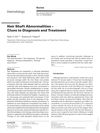TLDR Mutations in three genes cause Uncombable Hair Syndrome, leading to frizzy hair that can't be combed flat.
The study identified mutations in the genes PADI3, TGM3, and TCHH as the cause of Uncombable Hair Syndrome (UHS) in 11 individuals, revealing an autosomal-recessive inheritance pattern. These genes encode proteins crucial for hair shaft formation, and mutations led to structural and functional hair anomalies. The research included various analyses, such as whole-exome sequencing and cell culture experiments, demonstrating reduced enzymatic activity and protein dysfunction. The findings provided a molecular genetic basis for UHS, enhanced the understanding of hair physiology, and suggested potential targets for therapeutic intervention.
 47 citations
,
January 2013 in “International Journal of Cosmetic Science”
47 citations
,
January 2013 in “International Journal of Cosmetic Science” Hair diversity is influenced by complex genetics and environmental factors, requiring more research for practical solutions.
108 citations
,
October 2003 in “Journal of biological chemistry/The Journal of biological chemistry” Trichohyalin makes hair follicles stronger.
124 citations
,
November 2000 in “The journal of investigative dermatology/Journal of investigative dermatology” PAD3 plays a key role in hair and skin protein structure and may be linked to skin diseases.
135 citations
,
October 1997 in “Journal of biological chemistry/The Journal of biological chemistry” Trichohyalin is modified by enzymes to form strong structures in hair cells.
33 citations
,
September 1987 in “American Journal of Medical Genetics” Uncombable hair is inherited dominantly with complete penetrance.
101 citations
,
July 1985 in “Journal of the American Academy of Dermatology” Biotin improved hair growth and combability in one child with uncombable hair syndrome.
 44 citations
,
January 2005 in “Dermatology”
44 citations
,
January 2005 in “Dermatology” Hair problems can be caused by genetics or the environment, and treatment should focus on the cause and reducing hair damage.
 12 citations
,
November 1987 in “Pediatric dermatology”
12 citations
,
November 1987 in “Pediatric dermatology” Four children had unmanageable pale blond hair due to uncombable-hair syndrome.


